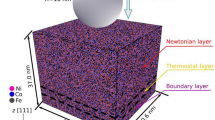Abstract
Stress relaxation and strain rate change tests were carried out in annealed Zr-1pctSn-1pctNb-0.1pctFe alloy at room temperature. The apparent and true activation volumes were determined and the results obtained from different techniques were compared. The stress dependence of activation volume was studied in a wide range of stresses, and an analysis was made in the light of the thermal activation theory. The results suggest that surmounting of the Peierls barrier is the rate-controlling factor in the room-temperature plasticity of the alloy. Dislocation exhaustion rate during initial stress relaxation is higher in the alloy.








Similar content being viewed by others
References
Caillard D, Martin J-L. Thermally activated mechanisms in crystal plasticity, Elsevier, Amsterdam, 2003.
Arieta F, Sellars C. Activation volume and activation energy for deformation of Nb HSLA steels. Scripta metallurgica et materialia 1994;30:707-12.
Bonneville J, Escaig B, Martin J. A study of cross-slip activation parameters in pure copper. Acta Metallurgica 1988;36:1989-2002.
Bonneville J, Viguier B, Spätig P. Repeated load transients for measuring the effective activation volume in A γ TiAl alloy. Scripta materialia 1997;36:275-81.
Chatterjee A, Sharma G, Sarkar A, Singh J, Chakravartty J. A study on cryogenic temperature ECAP on the microstructure and mechanical properties of Al–Mg alloy. Materials Science and Engineering: A 2012;556:653-7.
Dalla F, Spätig P, Schäublin R, Victoria M. Deformation behaviour and microstructure of nanocrystalline electrodeposited and high pressure torsioned nickel. Acta Materialia 2005;53:2337-49.
Sarkar A, Kapoor R, Verma A, Chakravartty J, Suri A. Hot deformation behavior of Nb–1Zr–0.1 C alloy in the temperature range 700–1700° C. Journal of Nuclear Materials 2012;422:1-7.
Sarkar A, Murty KL. Microstructure–mechanical property correlation of cryo rolled Zircaloy-4. Journal of Nuclear Materials 2015;456:287-91.
Sharma G, Mukherjee P, Chatterjee A, Gayathri N, Sarkar A, Chakravartty J. Study of the effect of α irradiation on the microstructure and mechanical properties of nanocrystalline Ni. Acta Materialia 2013;61:3257-66.
Sharma G, Sarkar A, Varshney J, Ramamurty U, Kumar A, Gupta S, et al. Effect of irradiation on the microstructure and mechanical behavior of nanocrystalline nickel. Scripta Materialia 2011;65:727-30.
Spätig P, Bonneville J, Martin J-L. A new method for activation volume measurements: application to Ni 3 (Al, Hf). Materials Science and Engineering: A 1993;167:73-9.
Wang Y, Hamza A, Ma E. Activation volume and density of mobile dislocations in plastically deforming nanocrystalline Ni. Applied Physics Letters 2005;86:241917.
Wang Y, Hamza A, Ma E. Temperature-dependent strain rate sensitivity and activation volume of nanocrystalline Ni. Acta Materialia 2006;54:2715-26.
Wei Q, Cheng S, Ramesh K, Ma E. Effect of nanocrystalline and ultrafine grain sizes on the strain rate sensitivity and activation volume: fcc versus bcc metals. Materials Science and Engineering: A 2004;381:71-9.
Chakravartty J, Kapoor R, Sarkar A, Banerjee S. Dynamic recrystallization in zirconium alloys. J ASTM Int 2010;7:1-17.
Mukherjee P, Sarkar A, Barat P, Bandyopadhyay S, Sen P, Chattopadhyay S, et al. Deformation characteristics of rolled zirconium alloys: a study by X-ray diffraction line profile analysis. Acta materialia 2004;52:5687-96.
Sarkar A, Chakravartty J. Hot deformation behavior of Zr–1Nb alloy: Characterization by processing map. Journal of Nuclear Materials 2013;440:136-42.
Sarkar A, Sinha S, Chakravartty J, Sinha R. Artificial Neural Network Modeling of In-Reactor Axial Elongation of Zr2. 5% Nb Pressure Tubes at RAPS 4 PHWR. Nuclear Technology 2013;181:459-65.
Sarkar A, Sinha S, Chakravartty J, Sinha R. Artificial Neural Network Modelling of In-Reactor Diametral Creep of Zr2. 5% Nb Pressure Tubes of Indian PHWRs. Annals of Nuclear Energy 2014;69:246-51.
Chakravartty J, Singh R, Sarkar A. Assessment of Deformation Behavior of Zr-2.5 Nb Alloy during Thermo-Mechanical Processing and under Service Condition. Procedia Engineering 2013;55:685-92.
Sarkar A, Boopathy K, Eapen J, Murty K. Creep Behavior of Hydrogenated Zirconium Alloys. Journal of Materials Engineering and Performance 2014;23:3649-56.
Sarkar A, Mukherjee P, Barat P. X-ray diffraction studies on asymmetrically broadened peaks of heavily deformed zirconium-based alloys. Materials Science and Engineering: A 2008;485:176-81.
Sarkar A, Mukherjee P, Barat P. Effect of heavy ion irradiation on microstructure of zirconium alloy characterised by X-ray diffraction. Journal of nuclear materials 2008;372:285-92.
Mukherjee P, Sarkar A, Barat P. Microstructural changes in oxygen-irradiated zirconium-based alloy characterised by X-ray diffraction techniques. Materials characterization 2005;55:412-7.
Chowdhury P, Sarkar A, Mukherjee P, Gayathri N, Bhattacharya M, Barat P. Studies of microstructural imperfections of powdered Zirconium-based alloys. Materials characterization 2010;61:1061-5.
Sarkar A, Mukherjee P, Barat P. Characterization of irradiated microstructure by X-ray diffraction line profile analysis. Metallurgical and Materials Transactions A 2008;39:1602-9.
Sabol GP, Kilp GR, Balfour MG, Roberts E. Development of a cladding alloy for high burnup. ASTM STP 1989;1023:227-44.
Lu L, Zhu T, Shen Y, Dao M, Lu K, Suresh S. Stress relaxation and the structure size-dependence of plastic deformation in nanotwinned copper. Acta Materialia 2009;57:5165-73.
Ray A, Barat P, Mukherjee P, Sarkar A, Bandyopadhyay S. Effect of transient change in strain rate on plastic flow behaviour of low carbon steel. Bulletin of Materials Science 2007;30:69-71.
Dunlop J, Bréchet Y, Legras L, Estrin Y. Dislocation density-based modelling of plastic deformation of Zircaloy-4. Materials Science and Engineering: A 2007;443:77-86.
Kombaiah B, Murty KL. Dislocation cross-slip controlled creep in Zircaloy-4 at high stresses. Materials Science and Engineering: A 2015;623:114-23.
Martin J, Kruml T. Characterizing thermally activated dislocation mobility. Journal of alloys and compounds 2004;378:2-12.
Martin J, Piccolo BL, Kruml T, Bonneville J. Characterization of thermally activated dislocation mechanisms using transient tests. Materials Science and Engineering: A 2002;322:118-25.
Evans A, Rawlings R. The thermally activated deformation of crystalline materials. Physica Status Solidi (b) 1969;34:9-31.
Sastry D, Prasad Y, Vasu K. An evaluation of rate-controlling obstacles for low-temperature deformation of zirconium. Journal of Materials science 1971;6:332-41.
Soo P, Higgins G. The deformation of zirconium-oxygen single crystals. Acta Metallurgica 1968;16:177-86.
Acknowledgment
The authors would like to thank Dr. P. Spätig for valuable suggestions in carrying out repeated stress relaxation tests.
Author information
Authors and Affiliations
Corresponding author
Additional information
Manuscript submitted March 30, 2015.
Rights and permissions
About this article
Cite this article
Sarkar, A., Chakravartty, J.K. Activation Volume and Density of Mobile Dislocations in Plastically Deforming Zr-1pctSn-1pctNb-0.1pctFe Alloy. Metall Mater Trans A 46, 5638–5643 (2015). https://doi.org/10.1007/s11661-015-3153-4
Published:
Issue Date:
DOI: https://doi.org/10.1007/s11661-015-3153-4




